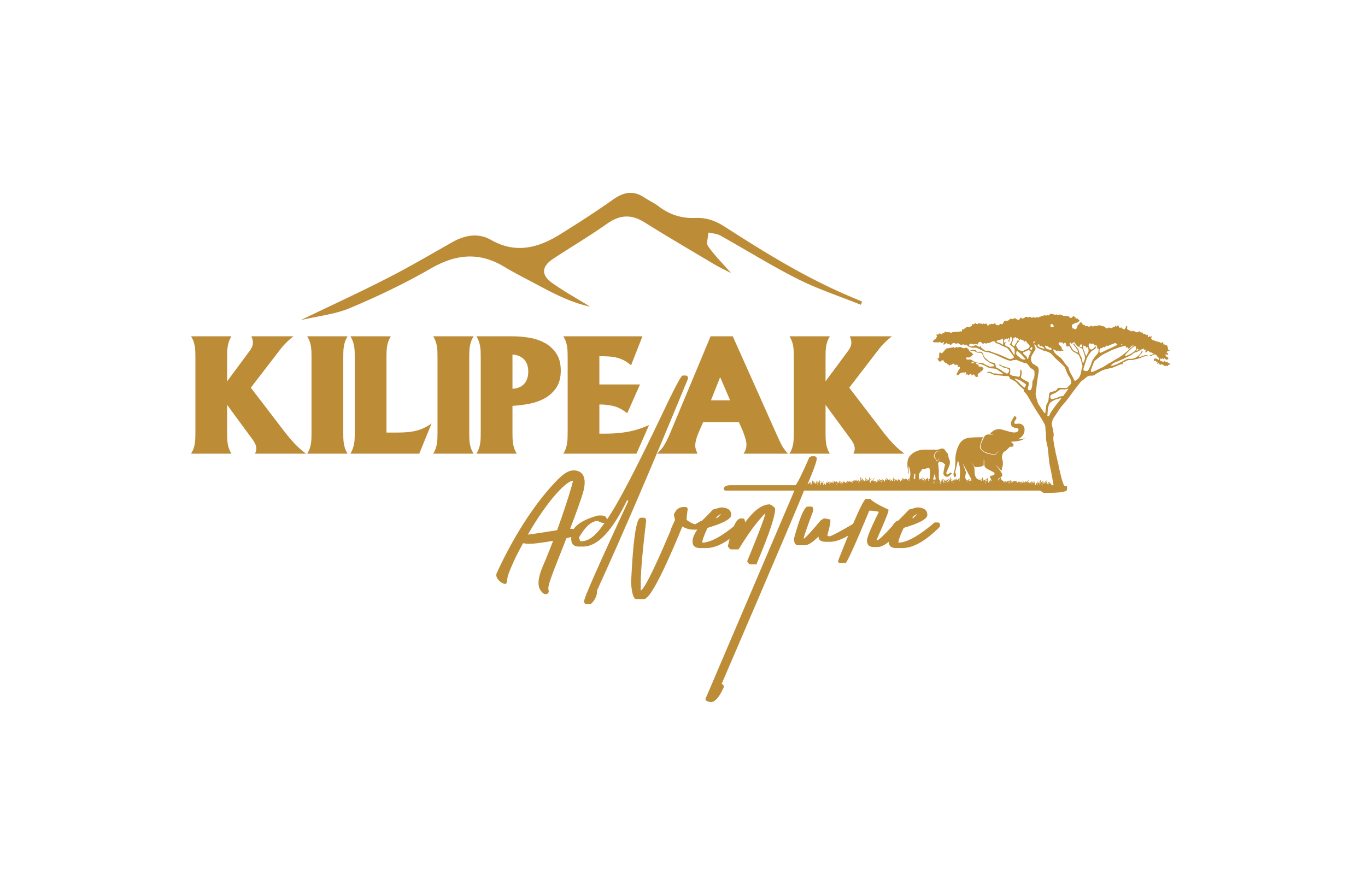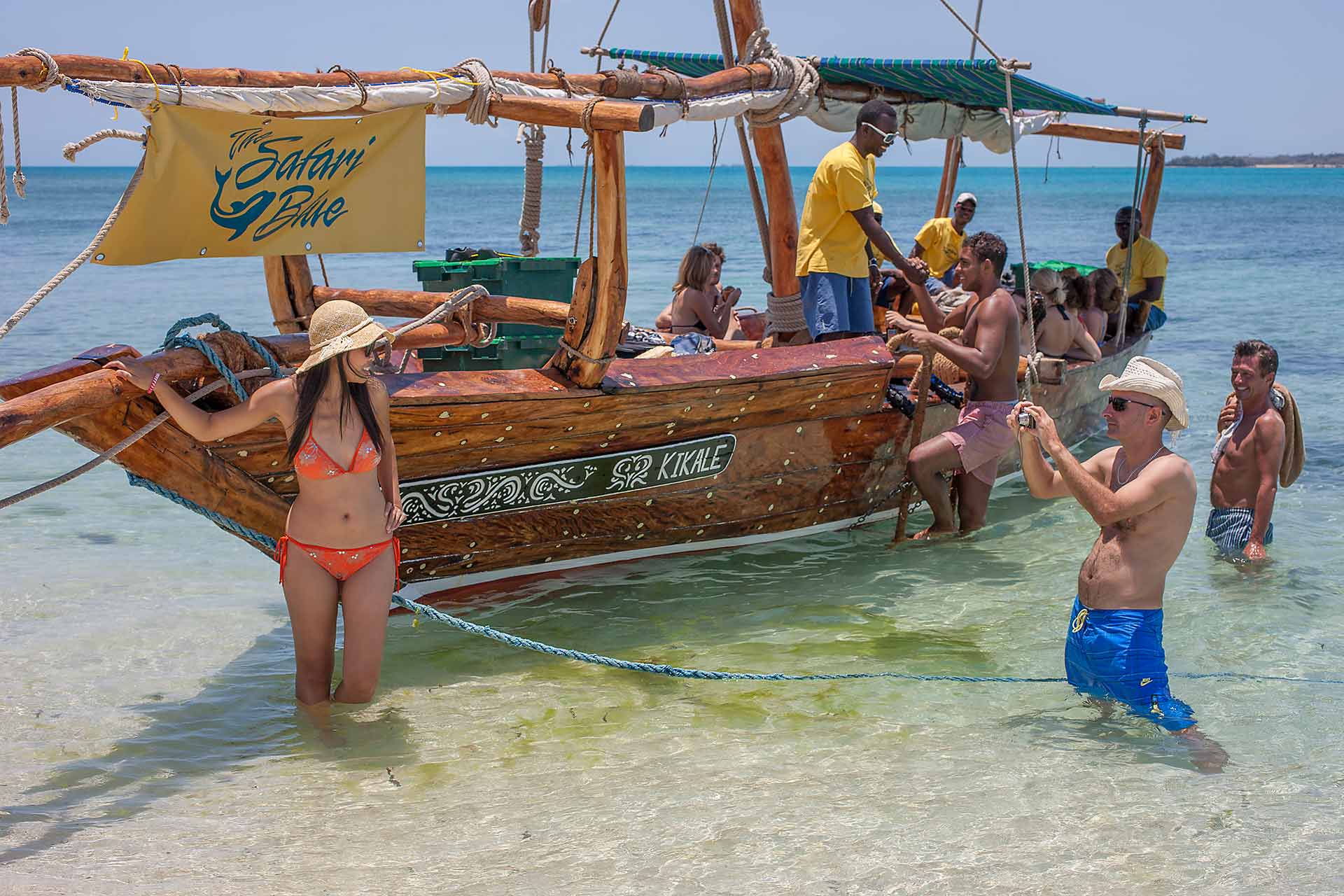
Zanzibar Beach Tour Holiday and Vacation Packages
6 Days Dolphins & Stone Town Tour In Zanzibar Beach with Kilipeak Adventure, Zanzibar is the Archipelago in the Indian Ocean and was the political and economic key to East Africa, which comprises two main islands, Unguja and Pemba with small habitable ones. Unguja is the main one with the Head of the State and named as Zanzibar is about 85 Kilometers long and 39 Kilometers wide.
Pemba is 72 Kilometers long and 25 Kilometers wide. The highest point of Zanzibar is 120 meters above sea level.
The capital of Zanzibar, located on the island of Unguja as Zanzibar Town and it is a cultural and historic Swahili City State and it is also located about 36 km off the coast of mainland Tanzania.
Until 2002 Zanzibar had a population of about 981, 754. Since the population growth is running about 3 % every year, it is now probably 1.2 million habitats in Zanzibar. Most of these habitats are practicing Islam of about 90 %, the rests are Christians and some Hindus.
DAY 1: STONE TOWN TOUR
Your program starts with a morning visit by walk on our Historical Stone Town Tour. This tour takes you through fabled Stone Town, where history appears to stand still. With visits to the House of Wonders, the Palace Museum (People’s Palace), and the Arab Fort amongst others, it is a fascinating look at the essence of Zanzibar. You will see Zanzibar’s bustling market, winding alleyways, ornately carved and studded doors, two cathedrals, and countless mosques!
Dinner and overnight stay at Coral beach resort: (Bed and breakfast).
DAY 2: HOUSE OF WONDERS
The House of Wonders shows the cultural and architectural influences of Zanzibar, Britain, Portugal, and Oman over the centuries. When it was built it was the most modern building in East Africa. It was the first building to have electricity and an elevator. The House of Wonders hosts a historical exhibition and offers insight into Zanzibari and Swahili culture. It is a very important and visually stunning historic building in Stone Town. The House of Wonders is the grandest and tallest building in all of Stone Town and is found in a prominent location in front of the Forodhani Gardens on the old town’s waterfront along Mizingani Road.
Dinner and overnight stay at Coral beach resort: (Bed and breakfast).
DAY 3: SPICE TOUR
Today you will go on an excursion to the spice and fruit plantations close to Stone town for the famous Spice Tour. We have developed a special spice tour with in-depth information not only about spices but also organically grown herbs and a detailed description of their traditional uses in medicine cosmetics and cooking. After the tour, we invite for an opulent lunch at our guides’ home, where you can taste the spices and fruits. After lunch, we take you to your beach resort.
On the way, you will pass Jozani Forest, the last habitat of the rare endemic Red Colobus Monkey. With a local guide, you stroll through Jozani Chwaka National Park and look at the rare monkeys. If you wish you can even wander down the boardwalk to the fascinating Mangrove Ecosystem.
Dinner and overnight stay at Coral beach resort: (Bed and breakfast).
DAY 4: DOLPHIN TRIP
Today you will visit Kizimkazi. Situated on the southern point of the island, Kizimkazi fishing village is home to several schools of bottle-nosed dolphins and Humpback dolphins, which can often be sighted following a short boat trip from the village. If you are lucky, you may be able to swim quite close to the dolphins, which can be a very rewarding experience. We are doing this trip in the afternoon to avoid the crowds of tourists in the morning, which in big numbers disturbing the dolphins.
Dinner and overnight at Fumba Beach Lodge: (Bed and breakfast).
DAY 5: SAFARI BLUE TOUR
Morning at 7:30 picked up from your hotel to Fumba village where you will meet your special boat, it is about visiting three different sand banks and you will stop in one of those for Sea food lunch where by later you do snorkeling and having a chance of seeing a dolphin. It is a full day back at 17:30 Fumba village and arrives at the hotel around 18:30. then back to the hotel.
Dinner and overnight at Tembo Hotel: (Bed and breakfast).
DAY 6: ZANZIBAR TO THE AIRPORT
Depending on your flight schedule and departure point you will be transferred to the Zanzibar Airport to take a flight back home. If you are flying out of Dar es Salaam or Nairobi, we will arrange a connection flight for you to catch your flight back home.
6 Days Dolphins & Stone Town Tour In Zanzibar Beach Includes.
• All transfers while in Zanzibar.
• All entries fees as listed in the itinerary
• All accommodations on bed, dinner & breakfast
• Pick up from hotel to Airport for flight
• All tours & excursion
• Lunch during tours & excursion
6 Days Dolphins & Stone Town Tour In Zanzibar Beach Excludes.
• International airfare & flights
• All items of a personal nature
• Airport departure tax
• Travel insurance
• Visa and Passport fees.
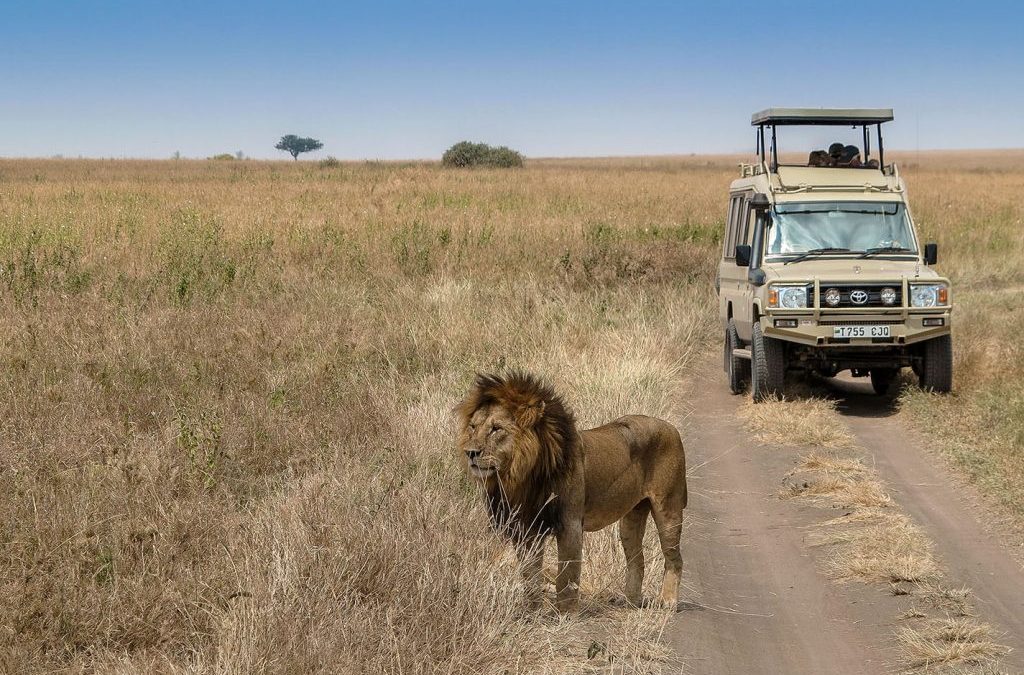
Combo Packages
Program Highlights
10 Days Tanzania Safari and Mount Meru Trekking in Lake Manyara, Serengeti, and Ngorongoro crater are the most famous national parks and conservation areas in Tanzania and hiking Mount Meru
All of our safaris use well-maintained Toyota Land Cruisers with roof hatches for unobstructed and up-close game-viewing.
Itinerary
Day 1: Welcome to Tanzania.
Arrive Kilimanjaro International Airport anytime and transfer to Arusha City at Ilboru Safari Lodge.
The rest of the day is free to relax and recover from your flight, laze by the pool or explore the town.
Day 2: Safari to Lake Manyara National Park.
Today we drive to Lake Manyara National Park for a full day of game drives. This is one of Tanzania’s smaller parks but still offers a rewarding and diverse safari experience. The lakeshore at Manyara teems with birdlife, and while you are looking for the birds, you might spot one of the elusive tree-climbing lions. There are a surprising number of other large mammals and the striking cliffs on the Rift escarpment form a dramatic backdrop. In the late afternoon, we make a short journey from the park to our hotel in Karatu
Day 3: Serengeti National Park.
We head towards the Serengeti National Park. after registration at Naabi gate at lunchtime. After lunch, we drive into the Serengeti itself and the rest of the afternoon is spent game viewing in the vast plains that are broken only by stands of acacia trees and the occasional kopje. In December, January and February we will normally meet the migration with large herds of wildebeest, zebra, and gazelle. There are always plenty of resident animals, such as giraffe, buffalo, and elephant, and many large predators such as lion, cheetah, and leopard. We return to our special tented camp for the night. (Kananga Special Tented Camp FB)
Day 4: A full Day Game Drive In Serengeti.
We have another full day in this wonderful park, rising early to make the most of our time. Our guides will choose the best spotting locations for the time of year; we can spend time at the Hippo pool watching these majestic animals laze about in the cool water happily living alongside the crocodiles, watch a big pride of lions, be in the middle of the migration, sometimes surrounded by wildebeest, sometimes by zebras, which travel with the wildebeest. we will hopefully see all of the plain games; elephants, giraffe, zebra, lions and if you are lucky the elusive leopard and cheetah, as well as huge amounts of the interesting birdlife, from the elegant secretary birds to the flightless ostrich. We return to our special tented camp for the night. (Kananga Special Tented Camp FB)
Day 5: Safari to Ngorongoro Crater.
We start the day with an early morning game drive serengeti before heading to Ngorongoro Area. Ngorongoro is a special place in that it is a Conservation Area, not a National Park; this means that the whole area is managed for both the animals and the local Masai people who graze their cattle alongside the indigenous wildlife. Finally, we descend into the crater. The crater walls provide a natural sanctuary for the animals, which means there is plenty to see: lions, elephants, buffalo, rhino, and leopard (if you are lucky). The only animal you won’t see here is a giraffe, whose long legs are unable to cope with the steeps sides of the crater. In the late afternoon, we travel just outside of Ngorongoro Conservation Area to Mto Wa Mbu (Nsya Tented Camp FB) or similar
DAY 6: Cultural Tour/ Masai Village Tour.
After breakfast, we will have short at Mto wa Mbu Village and visit masai boma, before head back to your hotel in Arusha for preparation of Mount Meru climbing (Ilboru Safari Lodge HB) or similar.
Mount Meru climbing program Start
Day 7: Miriakamba Hut (2,514 M).
We start from Momella Gate (1,500 m) in the late morning. The track soon passes some open grassland, with a good chance of seeing buffaloes and warthogs, and then continues as a steady climb through montane forest. We take lunch at, or near, the Fig Tree Arch, which is big enough to drive a car through! After lunch, the route continues through less dense forest, where there is an abundance of birds and monkeys. The black and white colobus monkeys are particularly fascinating to watch. By mid-afternoon, there are the first closer views of the towering cliffs and the Ash Cone. We reach Miriakamba Hut (2,514 m), situated in an idyllic grassy glade, in time to enjoy the last of the afternoon sun and beautiful views over the surrounding plains towards Kilimanjaro. [5-6 hours walking]
Day 8: Saddle Hut(3,570 M).
The walk from Miriakamba Hut to the saddle below Little Meru is a short day but a steep and sustained climb all the way. We walk through the attractive, open, and lush montane forest to reach the halfway point of Elephant Ridge. This has excellent views of the summit ridge and across most of the crater floor. Whilst resting, you might spot elephants or other animals from here. The path continues uphill through giant heather and other moorland vegetation to reach Saddle Hut (3,570 m), where lunch is waiting for us. The afternoon is free to rest and enjoy the views. The more energetic can make the short climb to the nearby summit of Little Meru (3,820 m) for superb views just before sunset. [3-6 hours walking]
Day 9: To Summit ( Socialist Peak 4556m) and down to Miriakamba
An early start at around 2 a.m. to climb steeply to Rhino Point (3,800 m), and then continue along an undulating ridge of ash and rock to reach Cobra Point (4,350 m) around sunrise. The views are stunning: the cliffs of the Crater rim, the Ash Cone rising from the Crater floor, Kilimanjaro floating on the morning clouds, and west towards the Rift Valley if the weather is clear. The summit of Socialist Peak (4,566 m) is an hour more on a superb but often steep path. The route back to Rhino Point in the sharp morning light on a narrow ridge between the sloping outer wall of the crater and the sheer cliffs of the inner wall is one of the most dramatic and exhilarating walks in Africa. We rest and have brunch at Saddle Hut before continuing the descent to Miriakamba Hut (2,514 m). [10-12 hours walking]
Note: The ridge between the summit and Rhino Point is not suitable for those suffering from vertigo. In icy conditions or in strong winds, it may be impossible for anyone to progress beyond Rhino Point.
Day10: Descend to Momella Gate
We take the direct route down towards Momella through open grassland and mixed forest, with good chances of seeing wildlife. This trail has excellent views back towards the crater and over the plains of the National Park. We should reach Momella Gate by late morning. Transfer back to Ilboru Safari Lodge (Arusha), where trip concludes. (2-3 hours walking)
Email us for a quote or give us a call to discuss your perfect safari booking today.
10 Days Tanzania Safari and Mount Meru Trekking Includes:
1. Full board accommodation whilst on safari in the above mentioned en suite tented camps and lodges
2. Private guide
3. Private 4 x 4 safari jeep with pop up roof for game viewing
4. Transfers in both directions between the International Airport
5. All Park Fees and crater fees.
Mount Meru Includes
6. Hotel Lodging the night after the climb
7. Transport from the hotel to the trailhead
8. Transport from the trailhead back to the hotel
9. All meals and water on the mountain
10. Rescue Fees
11. experienced local mountain guides, cook and camp crew
12. Large portions of fresh, healthy, nutritious food
13. Crisis management and safety procedures
14. Fair and ethical treatment of porters
15. 3 nights fully supported in mountain huts on a multi-share basis
16. group camping and catering equipment (sleeping bag not included – can be hired locally
10 Days Tanzania Safari and Mount Meru Trekking Excludes
1. Tanzania Visa:
2. Personal Expenses (e.g. laundry, telephone, beverages, etc.)
3. Meals not listed above
4. Optional Tours (balloon rides USD. 500 per person etc)
5. Tips and any items of personal nature.
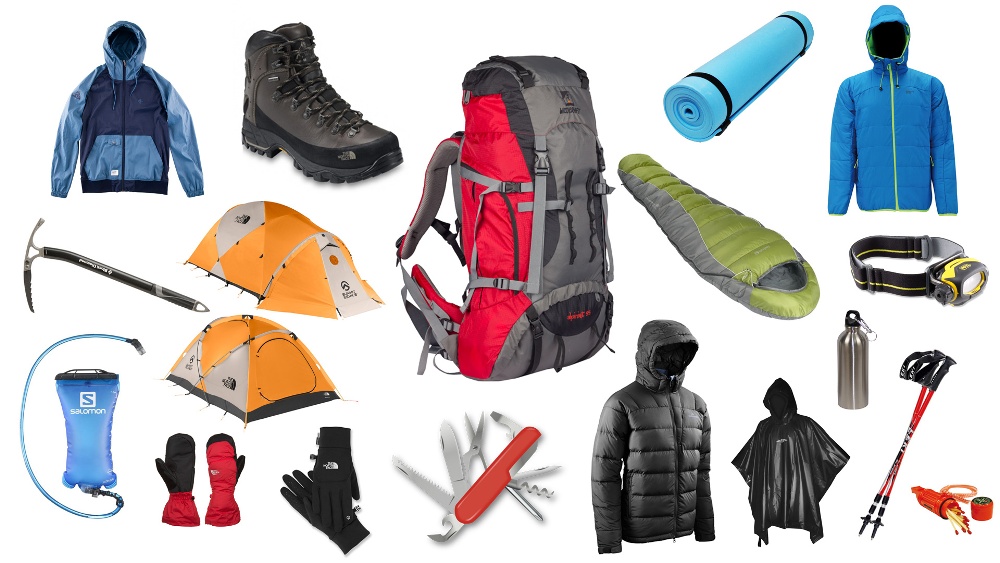
Blog News
Kilimanjaro Packing List | Best Gear for Kilimanjaro Trip
Now that you’ve made the decision to climb the highest peak in Africa, it’s time to prepare. We know that planning a Kilimanjaro packing list can seem a daunting task, so we’ve made it as easy as possible for you by putting together an extensive packing guide that you can follow! If you pack everything in our list, you can rest assured you’ll be fine on your Kilimanjaro trek.
During a day on Kilimanjaro, the temperatures can easily range from the high 20’s (centigrade) right down at night to -15c. To cope with this huge range in temperature your clothing and kit strategy needs to be based around combining lots of thin layers that you build up and take off as the weather demands.
Please note that Tanzania is implementing a ban on the use of single-use plastic bags on 1st June 2019. Please ensure that none of the items in your luggage are packed in plastic bags – if you are looking to separate items in your bag, please consider re-usable ‘packing cubes’. Please also be aware that disposable plastic bottles are not permitted on Kilimanjaro National park.
Kilimanjaro National Park operates an absolutely strict limit of 15kg per porter for your main equipment bag, which includes your sleeping bag. This is more than sufficient for your needs on the mountain. Your bag will be weighed before you leave the hotel to start the climb and if it is overweight you will have to check unnecessary take items and leave them at the hotel or we can arrange for an extra porter on the briefing time.
Kilimanjaro Packing List | Best Gear for Kilimanjaro Trip see below
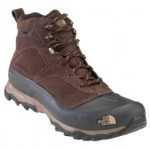
Solid Hiking Boots– Boots should have high ankle support with a solid Vibram®, or equivalent, sole. Gore Tex®, or other waterproofing, is recommended to have for wet days as well as added insulation. Be sure to break your boots in at least 4 WEEKS prior to departure. Additionally, bring a spare set of laces.
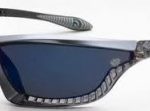
Sun Glasses – Your sunglasses should have 100% UV protection and should reduce glare as well as visible light. The frames should be lightweight with a wrap-around design for enhanced grip and staying power. Additionally, side shields are recommended to block peripheral light.
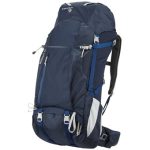
Day Pack – The most important things to look for if you need to purchase one are size (30L is good), hydration pack compatibility, hip, and chest straps, internal frame, good padding on shoulder straps, and water bottle holders
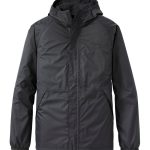
Water/Windproof Jacket – Your water/windproof jacket is your outer water-repellent layer. Gore-Tex, seam-sealed is recommended as well as a hood for added warmth.
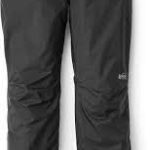
Water/Windproof Pants – Your water/windproof pants will be worn on summit day as well as on rainy afternoons. These pants are essential for warmth and should be Gore-Tex lined and have lower leg zips.
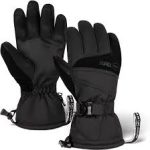
Water/Windproof Mittens or Gloves – These are used for extreme temperatures and primarily worn on summit day. Be sure your gloves or mittens have a wrist cord as well as a reinforced palm to maintain grip during wet conditions. A removable liner is essential for drying, washing, and replacing.
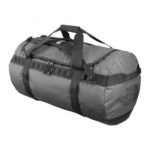
2 large duffel bags – One we will leave at the hotel in Arusha to store non-essential gear when on the mountain (such as clean clothes for changing when off the mountain and for onward travel) and the other for carriage by the porters when on the mountain.
THINGS TO KEEP IN MIND ABOUT THE ESSENTIALS
Look for items that will add less volume to your overall pack. We will be using porters to carry our equipment however they are limited in the amount each can carry. Heavy synthetic materials will be very limiting and could cause issues when packing up for the hike.
2 pairs of synthetic warm weather trekking socks – These socks are for trekking in the warmest part of the day since they are made of a Coolmax® fabric. What is Coolmax®? – CoolMax® wicks moisture dries quickly and breathes well, keeping your feet dry and preventing blisters.
4 pairs heavier synthetic or wool blend socks – Your wool socks are ideal for around camp when the temperature drops as well as on cold mornings. Merino wool is very comfortable and dries quickly with fewer odors than synthetic blends.
2 pairs long underwear top – This will be your base layer for colder mornings, evenings, and days where the temperature drops considerably. The material is lightweight, tight-fitting, moisture-wicking, and comfortable.
2 pairs long underwear bottom – This will be your bottom base layer for colder mornings, evenings, and days when the temperature drops considerably. The material is lightweight, tight-fitting, moisture-wicking, and comfortable.
Warm pants – These pants are ideal for evenings around the camp and cold days on the trail. Typically made of lightweight fleece and Wind Pro material, these pants should offer the added warmth in case of cold nights or high winds on the summit.
Fleece Top – This Polartec® 200 weight top will provide added warmth during the evenings as well as on a cold morning starts. Please look for fleece material and stay away from cotton sweatshirts. Ideally, this item is worn over the thermal base layer and underneath your water/windproof jacket.
2 pairs of Shorts/Pants for Hiking- These convertible shorts/pants will be what we hike in every day. They should be of a lightweight, quick-drying nylon material. Some come with UPF protection and mosquito protection.
2 pairs of long or short sleeve shirts for the trail – Your trekking shirt is what we should wear early in the climb in warmer climates. The shirt is moisture-wicking, lightweight, and designed for multi-day hikes.
Mid-Layer Top – This shirt is a long sleeve version of the one provided above. The long sleeve trail shirt offers added warmth, more protection from the sun, and an additional layer for evenings and early morning starts.
Warm Hat – This fleece or wool hat is ideal for evenings and will be valuable in the event of cold weather and temperatures on the summit. The hat should be tight-fitting with minimal loose ends.
Lightweight Gloves – Fleece gloves are essential. Look for gloves that are Polartec® 200 weight with leather reinforced palm. For more protection wind proofing is available and will add an extra layer of warmth.
Balaclava – The balaclava provides added warmth on summit day and colder evenings. The balaclava should be of synthetic or wool material, lightweight, and close-fitting.
Sun hat – Your sun hat should be worn at the lower camps and should provide ample coverage for the face. A full brimmed hat is good for added shade and increased sun protection. Additionally, a neck scarf should also be considered to protect the back of the neck”.
Waterproof breathable Gaiters – Your gaiters should be lightweight and durable. Look for Gore-Tex lined with the ability to fit over your boots. Velcro or adjustable sides for easy access is recommended.
Down Jacket – 800 fill down jacket will add much need warmth for cold evenings as well as the added layers for summit day. Down is recommended for its comprehensibility and is comfortable around camp in the early nights on the climb. Patagonia, Mountain Hardware, Marmot, and North Face are brands the guides wear.
ADDITIONAL ITEMS:
Head Lamp- Petzl® and Black Diamond® make several models of small and efficient headlamps. Look for ones that have multiple lighting levels, LED bulbs, and uses AAA batteries.
* Please bring at least 3 sets of spare batteries to ensure ample lighting on your summit attempt.
Camp shoes (Teva, Crocs, Sandals) – These are great for around camp after a long day on the trail. These can also be used for creek crossings that may be higher than the boot. Flip flops work well in warmer climates but are not as effective during cold nights.
Hydrator – Hydrators are ideal when hiking for several hours because they enable you to drink slowly and frequently. 2-3 liters is a good size and should fit easily into your pack. All Camelbaks® come with a bite valve, or on/off switch, as well as a large access port for filling. You must bring a NEOPRENE SLEEVE for the hose to prevent freezing.
Bug Spray – DEET-based products work well and we find that the spray-on versions last longer and are less messy. 4-6 ounce repellents that are perspiration and splash resistant are great.
Sun Screen – 30 SPF or higher is recommended as well as waterproof and sweatproof. 8 ounces will be plenty and we typically carry one with 45+ SPF for our faces and a 30 SPF for other exposed areas. Banana Boat, REI, Kinesis, and All-Terrain are good options.
2 wide mount water bottle – A 1-liter water bottle is essential for hydrating at lunch, around the camp, and refilling throughout the day. Stay away from glass and heavy metals and look for lexan® for durability.
* For males, a third water bottle should be considered for use as a potty at night and must be labeled accordingly.
Pillow– A Thermarest® pillow that compresses down or folds into itself is ideal. A good benchmark for size and weight is 18 X 14 inches and 9 ounces total.
Dry Bag – A 20 liter + dry bag is great for ensuring your personal items are safe in case of rain. Cameras, wallets, money, and any other valuables can be kept dry at all times.
Pack Cover – The pack cover is an additional item we recommend everyone carry in case we encounter heavy rains. The pack cover should have a drawstring cord and elastic edges to fit firmly over your bag. A 40-liter cover will work well on any day pack.
Trekking Poles – Collapsible poles are great for steep downhill terrain and assistance up the hill. If you have knee problems they reduce the impact on your joints by 20-30%. A nice soft foam grip will help prevent blisters and the poles with an aluminum shaft are durable and lightweight.
Camp Towel – the camp towel should be of a polyester-nylon blend that dries quickly and compacts tightly in your pack. The large (50 X 27 inches) is a good size and can be used to wash up at the end of the day. Stay away from the house or beach towels.
Kilimanjaro Packing List | Best Gear for Kilimanjaro Trip
optional items:
- Camera
- Paperback book
- Journal with pen or pencil
- Person First Aid Kiband, moleskin or second skin, Ibuprofen, Aspirin)
- Hand sanitizer
- Power Banks
- Hand & feet warmers (2X) – Gel/ air activated are best
- Bandanna
- Cell phone (with solar charger e.g. solar monkey charger) since you tri and quad-band phones work on Kilimanjaro
- Flavored chocolate/energy bars for snacks
- A supply or re hydrate sachets
- 2 extra garbage bags for waterproofing and separating dirty laundry
- Earplugs
- iPod or MP3 player
- Pocket knife
Water-flavoring to mask the iodine taste in the purified water
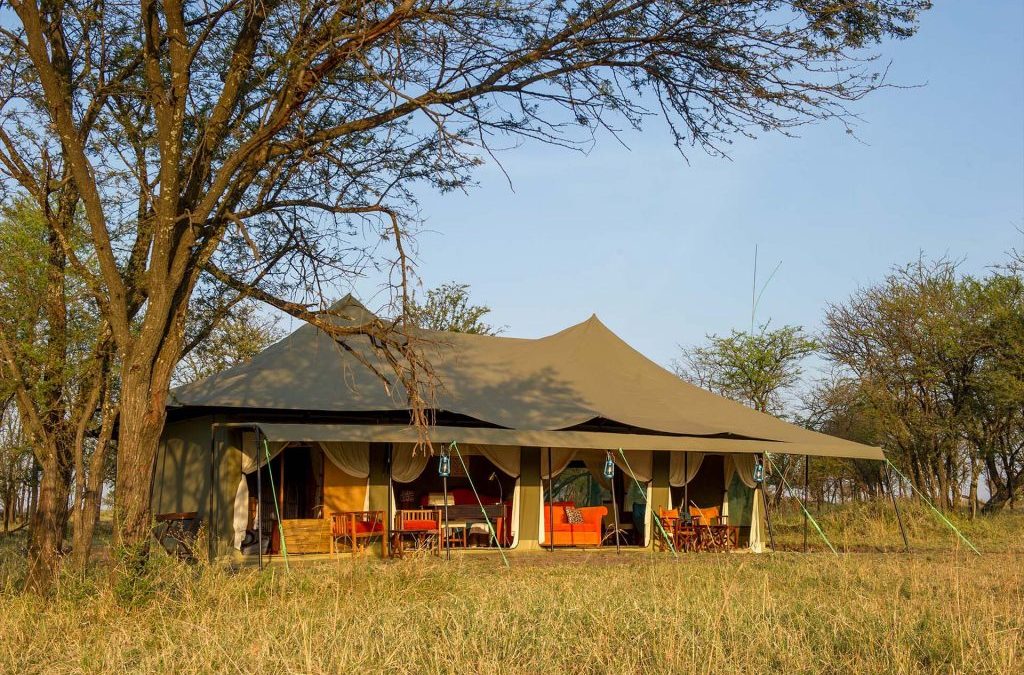
Luxury & Special Safari Packages
HIGHLIGHTS
- Visit the top national parks of Tanzania
- Enjoy unabashed luxury through amazing amenities and the stunning ambiance of your hotel
- Visit Tarangire National Park, Ngorongoro Crater, and Serengeti National Park
- Discover the best of African wildlife
This safari is ideal for families seeking for an ultimately relaxing holiday as well as for couples on a honeymoon who want to experience all of Tanzania’s top safaris, stay close to nature, and be spoiled by the luxurious amenities and ambiance of your accommodations.
An experience like no other, a perfect fusion of cultural immersion while indulging in nature’s beauty through the hospitality of African people. Top this with wildlife immersion winding through Tanzania’s top safari parks such as Tarangire National Park, Ngorongoro Crater, and Serengeti National Park.
This is exactly how you imagined your dream holiday to be, likely even better!
Day 1: Arrive In Tanzania.
Arrive anytime at Kilimanjaro International Airport (JRO), there will be Kilipeak Adventure safari driver waiting at the airport to pick up you to Arusha, where the rest of the day is at leisure. We stay at Grand Melia Hotel, which is beautifully located on the coffee farms and is a perfect place to prepare for your adventure.
We will gather in the hotel for a pre-safari briefing,
Dinner and overnight at Grand Melia Hotel: Half board.
Day 2: Arusha National Park.
We depart from Grand Melia Hotel. We go through Arusha National Park, where we view the herds of buffalo in the spectacular Ngurdoto Crater, the flamingos of the Momela Lakes, and the imposing peak of rugged Mount Meru. Arusha National park houses a variety of wildlife, including giraffes, zebra, colobus monkeys, leopards, and hyenas, in the park’s small but bustling 53 square miles of natural habitats. Enjoy a picnic lunch while gazing at the rolling hills and wooded savannas of this national treasure.
At the end of the day, we return to your lodge in Arusha.
Dinner and overnight at Grand Melia Hotel: Half board
Day 3: Tarangire National Park.
After breakfast, we will drive to Tarangire National Park, for excellent game viewing. Tarangire is a small park that offers some excellent sights. Generally, in the dry seasons, Tarangire comes alive as wildlife and birdlife congregate on the Tarangire River, which is a permanent source of water. We spend the night in our lodge beautifully set outside the park with stunning views and a unique atmosphere.
Dinner and overnight at Acacia Farm Lodge: Full board.
Day 4: Ngorongoro Crater Tour.
Early breakfast then drives to Ngorongoro Conservation Area. Ngorongoro is a special place in that it is a Conservation Area, not a National Park; this means that the whole area is managed for both the animals and the local Masai people who graze their cattle alongside the indigenous wildlife. Finally, we descend into the crater. The crater walls provide a natural sanctuary for the animals, which means there is plenty to see: lions, elephants, buffalo, rhino, and leopards (if you are lucky). The only animal you won’t see here is a giraffe, whose long legs are unable to cope with the steep sides of the crater. In the late afternoon, drive to the hotel around the crater rim
Dinner and overnight at Ngorongoro Serena Lodge: Full board.
Day 5: Serengeti National Park.
You will wake up early in the morning for breakfast then we set off again further in the wilderness to Serengeti National Park, the land of the big cats and home to the famous Great Wildebeests Migration. We will stop briefly at Naabi Hill gate for registration then the rest of the day will be spent doing game drives in the endless plains. Game drives will go on until late in the afternoon when you will check-in at Serengeti Acacia Tented Camp.
Dinner and overnight at Serengeti Sametu Camp: Full board.
Day 6: Serengeti National Park.
Early morning game drive is a good option this day to spot the nocturnal species and the diurnal ones as they rise for a new day. During the morning also many animals will easily be spotted by the sides of the tracks as they escape the morning dew, and enjoy the songs of the rising birds. Depending on the time that you season that you visit Serengeti you can be lucky to see the herds of the Great Wildebeests Migration (ask our experts for their location). Even without the wildebeest Migration herds in Serengeti; thousands of resident animals including buffaloes, leopards, cheetahs, lions, elephants, topis, Thompsons, and Grant’s gazelles, impalas, warthogs, and many bird species that never are resident to this incredible park.
Dinner and overnight at Serengeti Sametu Camp: Full board.
Day 7: Departure Day
Enjoy the morning at leisure before your transfer to Seronera Airstrip, connecting to Kilimanjaro International Airport for the flight back home, or proceed with other tours to Zanzibar with Kilipeak Adventure.
E-mail us at any time to discuss your trip and get an accurate quotation.
7 Day Best Tanzania Luxury Safari Includes:
1. Full board accommodation whilst on safari in the above mentioned luxury Hotels/lodges
2. Private safari guide
3. Private 4 x 4 safari jeep with pop up roof for game viewing
4. Transfers in both directions between the International Airport
5. Park fees
6. Crater fees
7. All meals while on safari
8. Airport Arrival/Departure Meet and Greets at the airport
9. On safari – Vehicles equipped with ice chest with mineral water, wildlife guidebook, Karibuni welcome packet with useful information for all guests
10. Government taxes, VAT, and service charges relating to accommodation and included meals
7 Day Best Tanzania Luxury Safari Excludes:
1. Tanzania Visa: $50 per person on arrival, USA and Canada passport holders USD.100
2. Personal Expenses (e.g. laundry, telephone, beverages, etc.)
3. Meals not listed above
4. Optional Tours (balloon rides )
5. Tips and any items of personal nature.
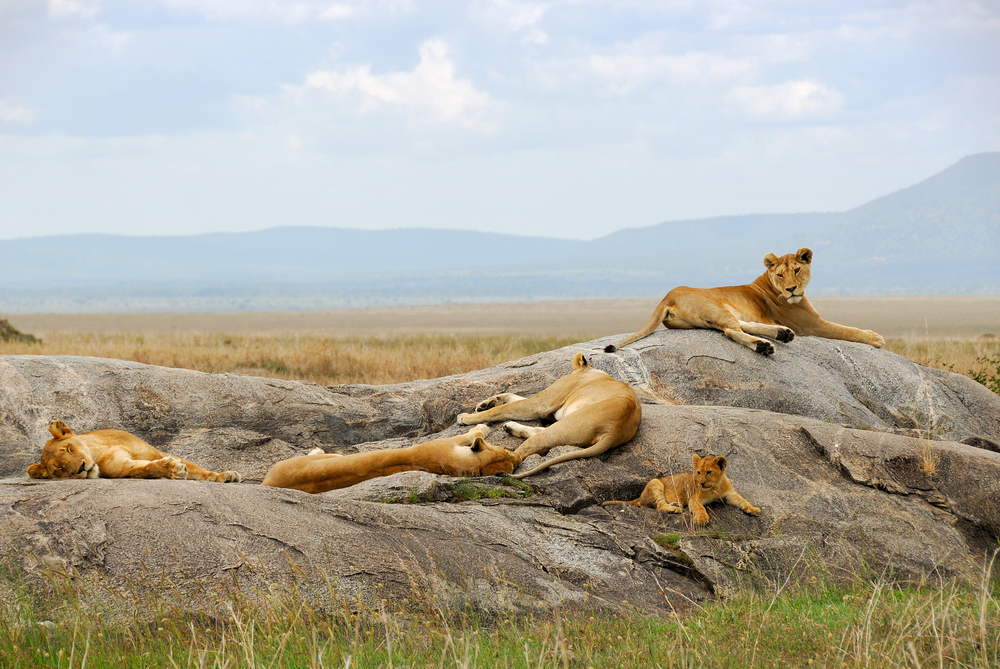
Safari Itineraries, Tanzania Lodge Safari
4 Days Affordable Safari In Tanzania into the best wildlife park in the Northern Tanzania Safari circuit, closer to Arusha town. Starting and ending in Arusha town this Simba Safari like the name suggests takes you to Ngorongoro Crater which is often regarded as the Eden of Africa to spot the pride of lions.
The safari takes you also to Arusha national park home of a white colobus monkey, Lake Manyara National Park a small beautiful lush green park that is famous for the legendary tree-climbing lions, and alsoTarangire National Park the best park to spot the African elephants with herds totaling up to 200 strong and even more in one herd.
Day 1: Game Drive In Arusha National Park.
We depart from your hotel in Arusha. We go through Arusha National Park, where we view the herds of buffalo in the spectacular Ngurdoto Crater, the flamingos of the Momela Lakes, and the imposing peak of rugged Mount Meru. Arusha National park houses a variety of wildlife, including giraffe, zebra, colobus monkeys, leopards, and hyenas, in the park’s small but bustling 53 square miles of natural habitats. Enjoy a picnic lunch while gazing at the rolling hills and wooded savannahs of this national treasure. At the end of the day, we return to your hotel in Arusha.
Accommodation at Mvuli hotel: Bed, Dinner, and Breakfast.
Day 2: Game Drive In Tarangire National Park.
Morning breakfast at Mvuli hotel, safari briefing and afterward we depart for Tarangire National Park. Your first experience of safari will be the thrilling game drive through the vastness of Tarangire National Park, arrive in good time for lunch. Afternoon game drives through the park followed by dinner and overnight.
Accommodation at Eileen’s Tree Inn Lodge or Similar: Bed, Dinner, and Breakfast and Lunch.
Day 3: Ngorongoro Crater Tour.
Today we visit the largest intact volcanic crater in the world, the magnificent Ngorongoro Crater. At more than 2,000 feet deep and 12 miles in diameter, the Ngorongoro Crater has one of the largest concentrations of wildlife in Africa. 30,000 animals make their home in this crater, making it an ideal place for sightings of the ‘big 5’ – lion, elephant, rhino, buffalo, and leopard. We enjoy a picnic lunch in this truly world-class attraction, also known as the ‘8th Wonder of the World’. Our dinner and overnight stay are at the rustic Lake Manyara.
Accommodation at Eileen’s Tree Inn Lodge: Bed or similar, Dinner, and Breakfast and Lunch.
Day 4: Game Drive In Lake Manyara National Park.
After breakfast, we depart from your lodge proceed to Lake Manyara National Park. Although small in size, this park is one of the most diverse reserves in the country. Lake Manyara covers two-thirds of the park. At the backdrop is the wall of the Great Rift Valley, before which lies the groundwater forest, areas of open grassland near the lake foreshore, and the Soda Lake. We enjoy a picnic lunch in this area, which consists of open grassy areas, hot springs, dense woodlands, and steep mountainsides. Lake Manyara National Park is a birding paradise that has more than 350 species of bird. The park is also famed for its unique and elusive tree- We will leave Lake Manyara National Park in the Afternoon to Arusha, with a prior arrangement to the Airport.
E-mail us at any time to discuss your trip and get an accurate quotation.
4 Days Affordable Safari In Tanzania Includes:
-Full board accommodation whilst on safari in the above mentioned en suite tented camps and lodges
-Private safari guide
-Private 4 x 4 safari jeep with pop up roof for game viewing
-Transfers in both directions between the International Airport
-Park fees
-Crater fees
-Airport Arrival/Departure Meet and Greets at the airport
On safari – Vehicles equipped with ice chest with mineral water, wildlife guidebooks
-Government taxes, VAT, and service charges relating to accommodation and included meals
4 Days Affordable Safari In Tanzania Excludes:
-Tanzania Visa: $50 per person on arrival, USA and Canada passport holders USD.100
-Personal Expenses (e.g. laundry, telephone, beverages, etc.)
-Meals not listed above)
-Tips and any items of personal nature

